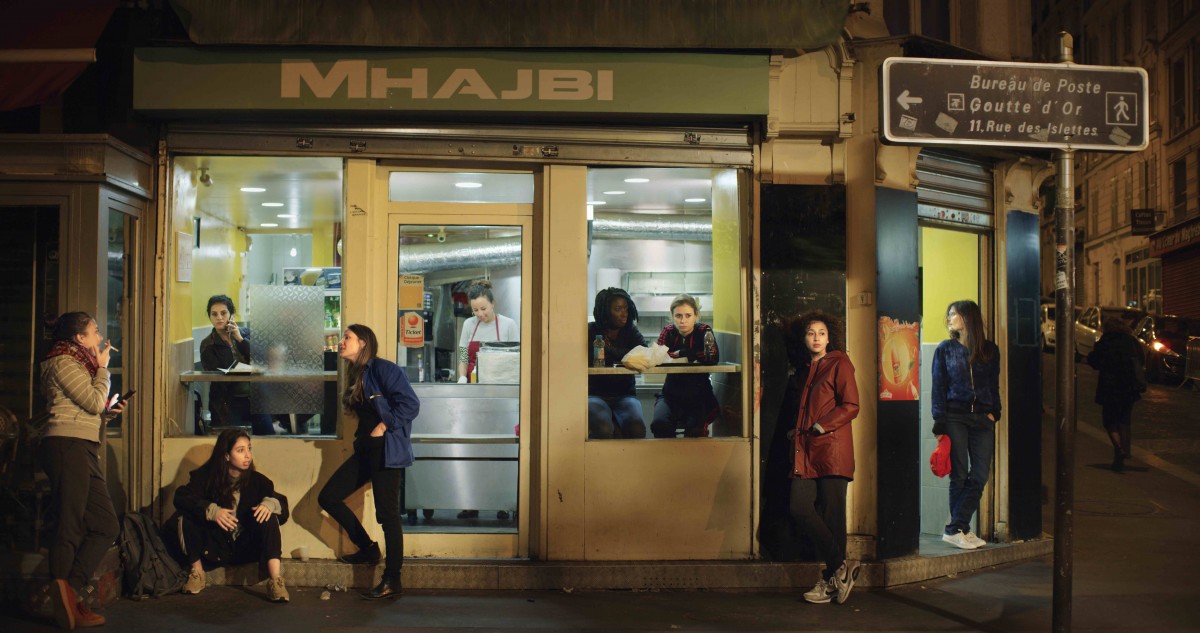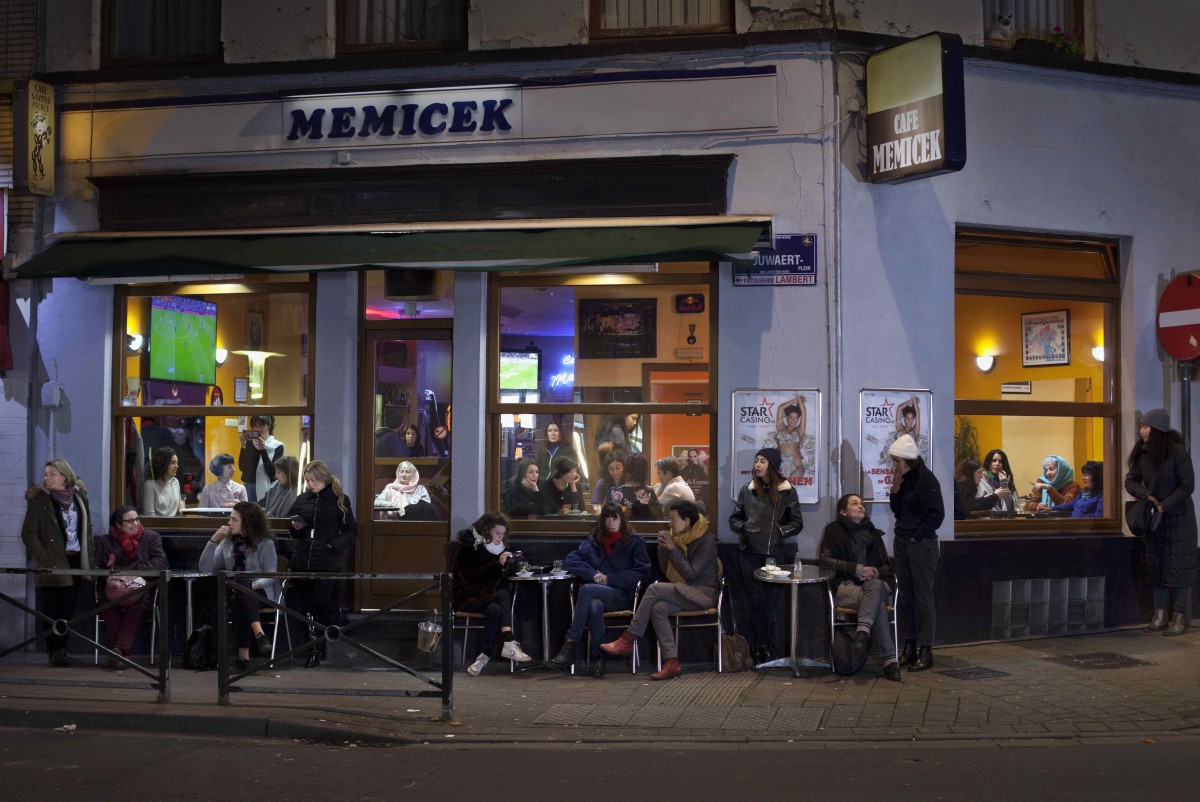 LES INTRUSES, series of photographs & video, 2019
LES INTRUSES, series of photographs & video, 2019
 LES INTRUSES, series of photographs & video, 2019
LES INTRUSES, series of photographs & video, 2019
The Moussem Collection project is a long-term trajectory with our partners Mu.ZEE and M HKA.
With Mu.ZEE in Ostend, Moussem focuses on young artists with a link to the MENA region, with extra attention for those who are active in Belgium. A young artist is invited every year as part of the Enter project, to show work in Mu.ZEE. A purchase of her/his work for the permanent collection will then follow.
Together with M HKA, Moussem continues to build on the multifaceted joint project Zonder Titel (Without Title) that was realised in 2007. This resulted, among other things, in the inclusion of work by 6 artists from North Africa in M HKA's permanent collection. Both partners are committed to a far-reaching cooperation around collection building in the coming years. Every year, an artist is supported, followed by an exhibition in the museum. Moussem and M HKA subsequently purchase work in co-ownership.
Randa Maroufi is a visual artist and filmmaker. She is inspired by people and their interactions on the street, in squares and in parks. A human being is a social animal that naturally seeks company. Mutual contacts are always accompanied by codes of conduct, patterns and routes. Maroufi observes these and then creates new images that explore the boundary between fiction and reality. She follows young people who are hanging around aimlessly in an abandoned, neglected theme park in Casablanca (Le Park, 2015). In Stand-by-office (2017), we see men in tailored suits walking around and interacting with colleagues in an office building in Amsterdam. They turned out to be refugees who had found temporarily ‘squatted’ accommodation in a municipality in West-Amsterdam. Today the refugees have left the building and it serves once again as counter. The film acts like a witness of this short intermezzo and specifically poses certain questions. What is false and what is true? Randa Maroufi uses strategies that are reminiscent of documentary genres, but on closer inspection the photographic and cinematic images prove to be staged. The people in the picture become characters. They are placed in the public sphere as pawns. Every detail in the image plays a role in the atmosphere created by the artist. Not a single pixel is left unused or uncontrolled. Although Maroufi mainly makes static and very slow images, they are anything but boring. The images are full of information that we do not want to miss. At the same time, we are overcome by a sense of uneasiness. Something is wrong. What is going on? With her work, the artist deliberately touches on a number of social themes, such as gender inequality and migration. She plays with our prejudice as well as our desire for stimuli and entertainment.
Randa Maroufi is invited by Mu.ZEE and Moussem to exhibit as part of Moussem Collection and the ENTER project by Mu.ZEE. In Being Places, the artist brings together a number of recent works:
With Les Intruses (2018-2019), the artist makes a series of photos in which she seeks out public spaces that, in an unspoken but undeniable manner, are usually populated and frequented by men. The rules that make such a spatial ‘distinction’ between men and women are, of course, unwritten. In the project Les Intruses - the invaders - the artist has women infiltrating some of those ‘male’ public spaces. In the images she stages, the women assume a key role and we see them hanging out in a Brussels café where football can be seen on a big screen. They populate a barber’s shop, a pita bar or a chip shop in Paris. We see a mise-en-scène of women behaving just like men each time. They adopt “manly” poses, hang out, play cards or watch football. We become aware of gender stereotypes and hidden expectations. Time seems to stand still. Mu.ZEE is exhibiting four images from this series Les Intruses. This is an unfinished project. Following the launch in Brussels and with a follow-up in Paris, the artist’s ambition is to infiltrate various other urban contexts.
The film Bab Sebta (2019) is the result of a yearlong observation of men and women who work on the border between Africa and Europe. Randa Maroufi, herself the daughter of a customs officer, specifically studies the daily flow of people and goods in Ceuta (Sebta in Arabic or Berber), a Spanish enclave of only a few square kilometres in Morocco. It is a safe haven for couriers and their contraband. Maroufi observes and then reconstructs the route taken by the people who cross the border every day. She portrays them frontally. As a filmmaker, she remains at a distance as the camera glides past waiting queues of tourists and smugglers. We see men and women, heavily laden like mules. They are all actresses and actors portraying their own lives. Randa Maroufi displays the choreography of their daily life - sometimes moving, often forced to wait for hours - and recreates the raw reality of everyday life in the port of Ceuta in a sublime cinematic way.
Diwana (2018-2020) is a series of blueprints in which Randa Maroufi asked smugglers in Ceuta to transcribe their daily route. The result is a floor plan, reconstructed from memory, on which the different actors - tourists, smugglers, police, customs - are subjectively marked. The blueprints or cyanotypes are confirmation of the smugglers’ informal system, but they also complement the more conventional floor plans drawn by architects and urban planners.
During her residency at Moussem in 2017, she creates a work in the series 'Les Intruses' and participates in the expo Raw Poetry during Moussem Cities Casablanca.
The Moussem Collection project is a long-term trajectory with our partners Mu.ZEE and M HKA.
With Mu.ZEE in Ostend, Moussem focuses on young artists with a link to the MENA region, with extra attention for those who are active in Belgium. A young artist is invited every year as part of the Enter project, to show work in Mu.ZEE. A purchase of her/his work for the permanent collection will then follow.
Together with M HKA, Moussem continues to build on the multifaceted joint project Zonder Titel (Without Title) that was realised in 2007. This resulted, among other things, in the inclusion of work by 6 artists from North Africa in M HKA's permanent collection. Both partners are committed to a far-reaching cooperation around collection building in the coming years. Every year, an artist is supported, followed by an exhibition in the museum. Moussem and M HKA subsequently purchase work in co-ownership.
Randa Maroufi is a visual artist and filmmaker. She is inspired by people and their interactions on the street, in squares and in parks. A human being is a social animal that naturally seeks company. Mutual contacts are always accompanied by codes of conduct, patterns and routes. Maroufi observes these and then creates new images that explore the boundary between fiction and reality. She follows young people who are hanging around aimlessly in an abandoned, neglected theme park in Casablanca (Le Park, 2015). In Stand-by-office (2017), we see men in tailored suits walking around and interacting with colleagues in an office building in Amsterdam. They turned out to be refugees who had found temporarily ‘squatted’ accommodation in a municipality in West-Amsterdam. Today the refugees have left the building and it serves once again as counter. The film acts like a witness of this short intermezzo and specifically poses certain questions. What is false and what is true? Randa Maroufi uses strategies that are reminiscent of documentary genres, but on closer inspection the photographic and cinematic images prove to be staged. The people in the picture become characters. They are placed in the public sphere as pawns. Every detail in the image plays a role in the atmosphere created by the artist. Not a single pixel is left unused or uncontrolled. Although Maroufi mainly makes static and very slow images, they are anything but boring. The images are full of information that we do not want to miss. At the same time, we are overcome by a sense of uneasiness. Something is wrong. What is going on? With her work, the artist deliberately touches on a number of social themes, such as gender inequality and migration. She plays with our prejudice as well as our desire for stimuli and entertainment.
Randa Maroufi is invited by Mu.ZEE and Moussem to exhibit as part of Moussem Collection and the ENTER project by Mu.ZEE. In Being Places, the artist brings together a number of recent works:
With Les Intruses (2018-2019), the artist makes a series of photos in which she seeks out public spaces that, in an unspoken but undeniable manner, are usually populated and frequented by men. The rules that make such a spatial ‘distinction’ between men and women are, of course, unwritten. In the project Les Intruses - the invaders - the artist has women infiltrating some of those ‘male’ public spaces. In the images she stages, the women assume a key role and we see them hanging out in a Brussels café where football can be seen on a big screen. They populate a barber’s shop, a pita bar or a chip shop in Paris. We see a mise-en-scène of women behaving just like men each time. They adopt “manly” poses, hang out, play cards or watch football. We become aware of gender stereotypes and hidden expectations. Time seems to stand still. Mu.ZEE is exhibiting four images from this series Les Intruses. This is an unfinished project. Following the launch in Brussels and with a follow-up in Paris, the artist’s ambition is to infiltrate various other urban contexts.
The film Bab Sebta (2019) is the result of a yearlong observation of men and women who work on the border between Africa and Europe. Randa Maroufi, herself the daughter of a customs officer, specifically studies the daily flow of people and goods in Ceuta (Sebta in Arabic or Berber), a Spanish enclave of only a few square kilometres in Morocco. It is a safe haven for couriers and their contraband. Maroufi observes and then reconstructs the route taken by the people who cross the border every day. She portrays them frontally. As a filmmaker, she remains at a distance as the camera glides past waiting queues of tourists and smugglers. We see men and women, heavily laden like mules. They are all actresses and actors portraying their own lives. Randa Maroufi displays the choreography of their daily life - sometimes moving, often forced to wait for hours - and recreates the raw reality of everyday life in the port of Ceuta in a sublime cinematic way.
Diwana (2018-2020) is a series of blueprints in which Randa Maroufi asked smugglers in Ceuta to transcribe their daily route. The result is a floor plan, reconstructed from memory, on which the different actors - tourists, smugglers, police, customs - are subjectively marked. The blueprints or cyanotypes are confirmation of the smugglers’ informal system, but they also complement the more conventional floor plans drawn by architects and urban planners.
During her residency at Moussem in 2017, she creates a work in the series 'Les Intruses' and participates in the expo Raw Poetry during Moussem Cities Casablanca.